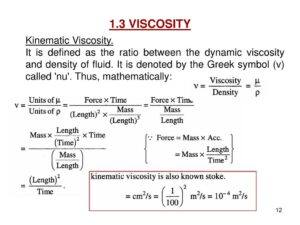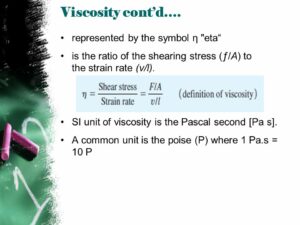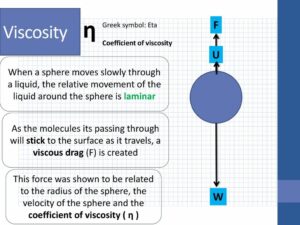Viscosity is normally signified by the Greek image μ (mu) and is characterized as the proportion of shearing pressure τ (Greek letter tau) to the rate of velocity and speed, v, which in numerical terms can be derived as DV/day where this is the subordinate of the velocity as for the distance y. The viscosity of the liquid is the interior blockage from the stream.
Please Scroll below if you want to Copy the Emoji/Symbol
Liquid encounters over each layer of it when exposed to distortion. Most fluids have protection from movement, which is known as viscosity. As it happens when the liquid’s layers move compared with each other. Viscosity is a proportion of a fluid thickness or protection from things going through it.
It is brought about by interior contact between the liquid layers as they pass through. At the point when liquid or fluid has high consistency, it restrains development. Due to its solid intermolecular pressures, it has a ton of inside erosion, which keeps layers from moving beyond each other. A liquid with low thickness streams quite evenly because its subatomic nature causes next to no grinding while moving. It is further explained in categories and types.
Symbol for Viscosity 2024
Symbol |
Copy & Paste |
| μ | μ |
| Mù | Mù |
| υ | υ |
Complete list of Symbol for Viscosity
μ, Mù,υ
How To Use sign for viscosity?

Viscosity is estimated at a proportion of shearing pressure to the velocity in a liquid. To use the symbol of viscosity you have to enter the below-mentioned formula.
| η = 2ga2/9v |
What is the unit of the coefficient of viscosity?
| Symbol | Quantity | Symbol | SI Unit |
| v, v | velocity, speed | m/s | meter per second |
| ω, ω | rotational velocity, rotational speed | rad/s | radian per second |
The newton-second per square meter is the SI unit for viscosity. The equivalent terms pascal-second and kilogram per meter each second are likewise ordinarily utilized. The balance is the CGS unit. The square meter each second is the SI unit for kinematic viscosity. It is named for Sir George Gabriel Stirs up and is once in a while utilized as a particular structure in the US.
As per Newton’s law of Viscosity:
τ = μ * (du/dy)
where τ is the shear force Newton per meter^2 for example N/m^2; du/day is the speed inclination ( u is the speed (m/s) and y is the viscosity of the liquid layer (m) which gives the unit of velocity angle according to second for example /s ) and μ is the coefficient of viscosity.
∴ μ = τ / (du/dy) i.e. N/ (m^2/s)
Thus, the S.I. units of coefficient of viscosity are N.s/m^2.
Is there viscosity in the air?

Yes, the air viscosity is not entirely settled by temperature. Viscosity in gasses emerges from atoms crossing layers of the stream and moving force between layers. This exchange of energy can be considered a frictional power between layers of the stream.
Utilizing air consistency (μ) of 185 × 10-5 N s/m2 at 25 °C, an entry speed (v0) of 5.3 cm/s, a PP web with a viscosity of 0.3 mm and premise weight of 30 gsm, a tension drop of the air across the trap of 2.8 mmH2O, and a PP having a polymer thickness of 0.91 g/cm3, can be utilized to compute the porosity of the web as 89%.
Calculating the above numbers and changing over the strain drop from mmH2O to N/m2 utilizing ‘ mmH2O = 9.81 N/m2, one acquires an
ACCPD¯
ACCP (D) of 20.73 μm.
What is the viscosity of water?
At room temperature, the powerful viscosity of water is around 0.89 mPas, while at 20 degrees Celsius, the viscosity of water is roughly 0.01 balance or 10-3 Pa.s (Pascal seconds). Pascal-second (Pa.s) or newton-second per meter squared (N.s/m2) is the SI unit for dynamic viscosity.
For fluids, for example, water, consistency, or viscosity can be considered a proportion of the fluid’s protection from the stream. It’s quite significant that the viscosity of water increments as the temperature decreases, as well as the other way around, i.e., the thickness of water brings down as the temperature climbs.
What is the viscosity meaning in chemistry and how the symbol is used?
A liquid’s viscosity is a proportion of its protection from deformation at a specific rate, and it corresponds to the conversational idea of “viscosity ” in fluids. The viscosity of a stone is not set in stone by its condition. The temperature, tension, and pace of mishappening of liquid can all influence its state.
As in certain circumstances, the reliance on these boundaries is minor, and in superfluids, zero consistency is just found at exceptionally low temperatures. Moreover, the second law of thermodynamics expresses that all liquids should have positive consistency, and liquid with zero thickness is alluded to as great or inviscid.
What are the Viscosity Measurements with Formulation?

The formulation has introduced a scope of imaginative consistency estimation innovations for modern and business fields taking care of formulations. As the arrangement of portfolio instruments for examining the mass rheological properties and dynamic viscosity of fluid, strong, and undefined items because of shear powers or destabilization over the long haul.
Also, it estimates comparable properties to adjust and additionally muddled and delicate designs like gels, feeble glues, and viscoelastic materials that could break under very low shear.
Check out Symbol for Wavelength
How do you write the symbol?
The viscosity symbol formula is mentioned below.
| F | = | force |
| More | = | the viscosity of the fluid |
| A | = | area of each plate |
| u/y | = | rate of shear deformation |
Unicode & UTF for the Symbol
| Preview | Η | η | Ͱ | ͱ | Ⲏ | ⲏ | ||||||
| Unicode name | GREEK CAPITAL LETTER ETA | GREEK SMALL LETTER ETA | GREEK CAPITAL LETTER HETA | GREEK SMALL LETTER HETA | COPTIC CAPITAL LETTER AYTA | COPTIC SMALL LETTER AYTA | ||||||
| Encodings | decimal | hex | dec | hex | dec | hex | dec | hex | dec | hex | dec | hex |
| Unicode | 919 | U+0397 | 951 | U+03B7 | 880 | U+0370 | 881 | U+0371 | 11406 | U+2C8E | 11407 | U+2C8F |
| UTF-8 | 206 151 | CE 97 | 206 183 | CE B7 | 205 176 | CD B0 | 205 177 | CD B1 | 226 178 142 | E2 B2 8E | 226 178 143 | E2 B2 8F |
More about the Symbol
Types of viscosity
There are two types of viscosity. Both of them are explained below.
Dynamic viscosity
It is the power expected to keep up with the fluid stream at a specific rate. Dynamic viscosity is typically utilized when the liquid or fluid is exposed to any outside force.
The unit of dynamic viscosity is Pa.s
where Pa is N/m^2 – SI unit of pressure
Kinematic viscosity
It is characterized as productive viscosity to the liquid. It shows the pace of energy movement and how quickly the liquid is moving when the liquid is exposed. Kinematic viscosity is otherwise called energy diffusivity. This is the proportion of the power to the idleness force. This force implies that the propensity of the liquid in the cylinder is to fall openly under the activity of gravity.
So it will attempt to go against any power which goes against it. So it’s the general strength of idleness and viscosity which will choose the net speed increase of liquid. This general strength of viscosity and idleness is addressed by kinematic viscosity.
The unit of Kinematic viscosity is m^2/s in SI units.
Viscosity Symbol

Viscosity is denoted by the symbol (η “eta”) is the proportion of the shearing pressure (F/A) to the velocity gradient (∆vx/∆z or dvx/DZ) in a liquid.
| η = | F/A |
| ∆vx/∆z |
What are a few other methods through which you can measure the symbol of velocity?
You can measure the viscosity by various methods by applying a viscosity symbol in it. A few of them are as follows.
Capillary Viscometers
Estimating viscosity using a capillary cylinder is one of the most seasoned techniques for deciding the kinematic viscosity of an example, expecting earlier information on the viscosity and volume of the example of interest. This liquid is gone through an upward U-container of known aspects and tiny measurements. The time taken for the example to go through the hairlike shape corresponds to its kinematic viscosity.
Rotational Rheometer
A rotational viscometer applies generally weak degrees of force to a fluid example to empower mechanical twisting. How much force is expected to cause a turn across an even plane in the example is estimated and is comparative with test viscosity.
Utilizing a rotational rheometer permits experts to plot a full stream bend of the material’s stream qualities in light of differing levels of shear force and decide further developed material boundaries.
Vibrating Viscometers
Viscosity can likewise be estimated by applying vibrations to the example and checking the impacts of the fluids and liquid. These can be evaluated by checking power input, the rot season of motions, or changes in the reverberated recurrence.

![Symbol for Wavelength [Copy & Paste] Symbol for Wavelength](https://emojisvilla.com/wp-content/uploads/2022/10/symbol-for-wavelength-364x205.jpg)
![Psi Symbol | Meaning [Copy & Paste] Psi Symbol](https://emojisvilla.com/wp-content/uploads/2022/10/Psi-Symbol-364x205.jpg)

![Symbol For Balance ☯ [Meaning] symbols-of-balance](https://emojisvilla.com/wp-content/uploads/2022/10/symbols-of-balance-list-364x205.jpg)

